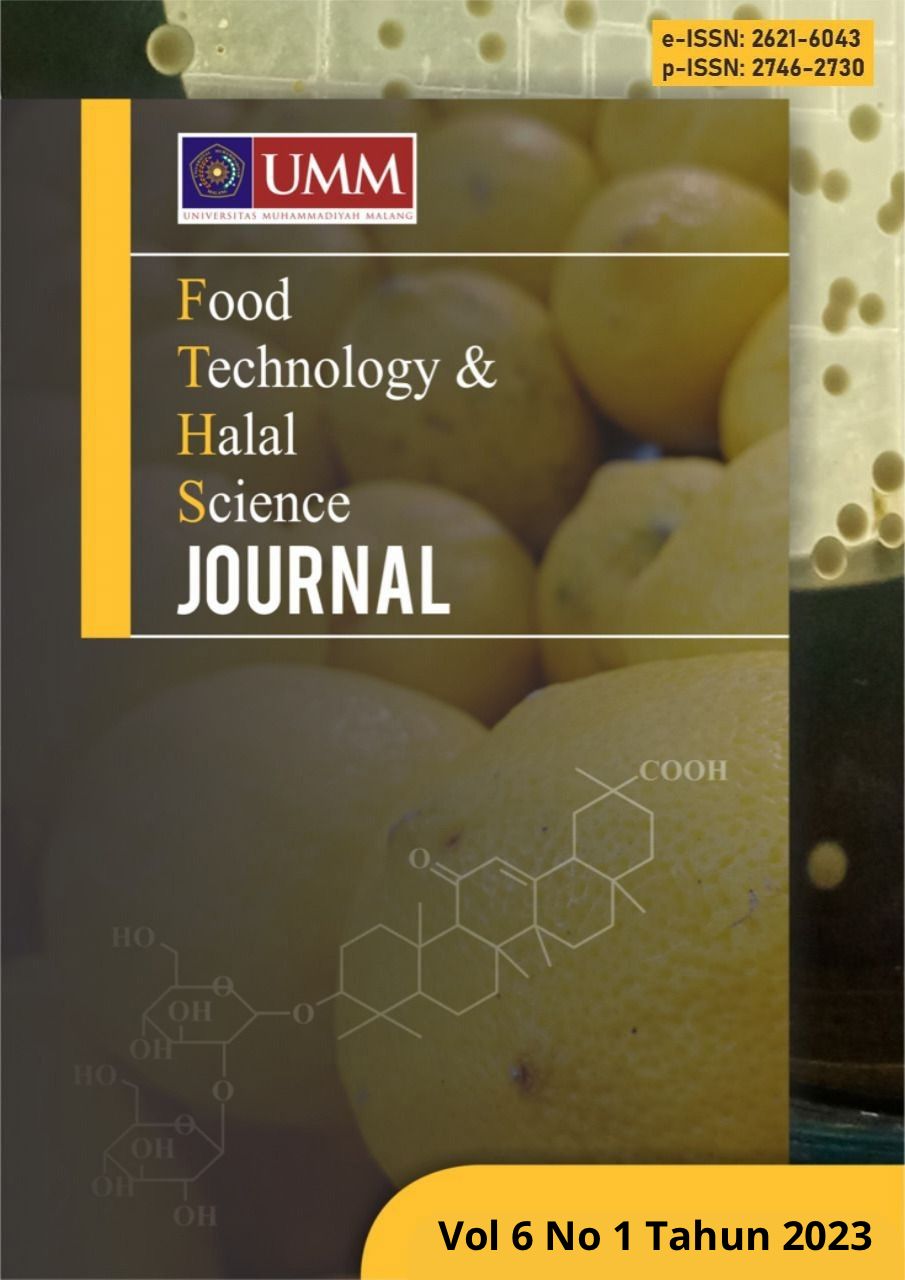PENGARUH KONSENTRASI ASAM KLORIDA (HCl) DAN WAKTU EKSTRAKSI PADA KARAKTERISASI PEKTIN KULIT JERUK BALI (Citrus maxima)
DOI:
https://doi.org/10.22219/fths.v6i1.28360Keywords:
acid, orange peel, protopectin.Abstract
Pectin or pectate compounds are complex polysaccharides with large molecular weights found in the middle lamella or intercellular spaces in higher plant tissues. The main function of pectin is as a thickener and gelling agent. So far, pectin production in Indonesia has not been widely known and developed. Pectin can be obtained from fruit peels, one of which is grapefruit peel. Grapefruit has a fairly high pectin content, around 30%. The purpose of this study was to find out how much pectin content is in grapefruit peels by determining the concentration of hydrochloric acid and the right extraction time to get the best yield and quality of pectin.
This study used a randomized block design (RBD) method with two factors, namely the concentration of hydrochloric acid 0.2 N; 0.25 N and 0.3 N and extraction times of 60, 90 and 120 minutes with three repetitions. The observations made were yield pectin, water content, ash content, equivalent weight, methoxyl content, galacturonic acid and degree of esterification. The data obtained based on the research results were analyzed statistically with variance (α = 0.05) and continued with the Duncan Multiple Range Test (DMRT).
The results showed that the concentration of hydrochloric acid 0.3 N and extraction time of 120 minutes produced the best pectin with yield 13.57%, moisture content 8.27%, ash content 7.53%, methoxyl content 6.79%, galacturonic content 261 .65%, the degree of esterification is 14.82% and it can be concluded that the test results for the characteristics of the pectin produced meet the established standards of the International Pectin Producers Association (IPPA).
Downloads
References
Budiyanto, A. Dan Yulianingsih. 2008. Pengaruh Suhu dan Waktu Ekstraksi Terhadap Karakteristik Pektin dari Ampas Jeruk Siam (Citrus nobilis L). Jurnal Pascapanen. 5 (2).
Budiyarti L., Etha N. F. 2013. Karakterisasi Pektin dengan Memanfaatkan Kulit Pisang Menggunakan Metode Ekstraksi. Laporan Penelitian. Teknik Kimia, Universitas Lambung Mangkurat. Banjarbaru.
Desmawarni, D. dan F. H. Hamzah. 2017. Variasi Suhu dan Waktu Ekstraksi Terhadap Kualitas Pektin dari Kulit Pisang Tanduk. Jurnal Online Mahasiswa Fakultas Pertanian Universitas Riau. Vol. 4 (1): 1-15.
Hanum, F., Tarigan, M. A., Menka, I., & Kaban, D. 2012. Ekstraksi Pektin Dari Kulit Buah Pisang Kepok (Musa paradisiaca). Jurnal Teknik Kimia, 49– 53.
Hariyati, M. N. 2006. Ekstraksi dan Karakterisasi Pektin dari Limbah Proses Pengolahan Jeruk Pontianak (Citrus nobilis var microcarpa). Skripsi. Institut Pertanian Bogor. Bogor.
IPPA (International Pektins Producers Association). 2002. What is Pektin. http://www.ippa.infohistory_of_pektin.htm.
Kesuma, N. K. Y., I. W. R. Widarta dan I. D. G. M. Permana. 2018. Pengaruh Jenis Asam dan pH Pelarut Terhadap Karakteristik Pektin dari Kulit Lemon (Citrus limon). Jurnal Ilmu dan Teknologi Pangan. Vol. 7 (4): 192-203.
Nurhaeni, N. A. Atjiang, J. Hardi, Diharnaini dan Khairunnisa. 2018. Ekstraksi dan Karakterisasi Pektin dari Kulit dan Dami Buah Cempedak (Artocarpus chempeden). Jurnal Riset Kimia (KOVALEN). Vol. 4 (3): 304-315
Sufy, Q. 2015. Pengaruh Variasi Perlakuan Bahan Baku dan Konsentrasi Asam Terhadap Ekstraksi dan Karakteristik Pektin dari Limbah Kulit Pisang Kepok Kuning (Musa balbisiana BBB). Skripsi. UIN Syarif Hidayatullah Jakarta. Jakarta.
Sulihono, A., Tarihoran, B. & Agustina, T. E. 2012. Pengaruh Waktu, Temperatur, dan Jenis Pelarut Terhadap Ekstraksi Pektin Dari Kulit Jeruk Bali (Citrus maxima). Jurnal Teknik Kimia. Vol. 18 (4), Hal. 1-8.
Hanum, F., I. M. D. Kaban dan M. A. Tarigan. 2012. Ekstraksi Pektin dari Kulit Buah Pisang Raja (Musa sapientum). Jurnal Teknik Kimia USU. Vol. 1 (2): 21-26
Wana, N. & Pagarra, H. 2018. Efektifitas Ekstrak Pektin dari Kulit Buah Jeruk Bali (Citrus maxima) Sebagai Antimikroba. Jurnal Ilmiah Bionature. Vol. 19 (2): 140-151.
Downloads
Published
How to Cite
Issue
Section
License
Copyright (c) 2024 Nur Alfiatus Zahro, Warkoyo, Vritta Amroini Wahyudi

This work is licensed under a Creative Commons Attribution 4.0 International License.
Authors who publish with this journal agree to the following terms:
- Authors retain copyright and grant the journal right of first publication with the work simultaneously licensed under a Creative Commons Attribution License that allows others to share the work with an acknowledgement of the work's authorship and initial publication in this journal.
- Authors are able to enter into separate, additional contractual arrangements for the non-exclusive distribution of the journal's published version of the work (e.g., post it to an institutional repository or publish it in a book), with an acknowledgement of its initial publication in this journal.
- Authors are permitted and encouraged to post their work online (e.g., in institutional repositories or on their website) prior to and during the submission process, as it can lead to productive exchanges, as well as earlier and greater citation of published work (See The Effect of Open Access).










